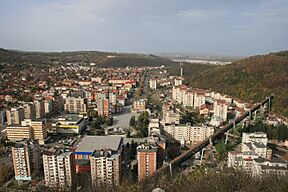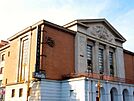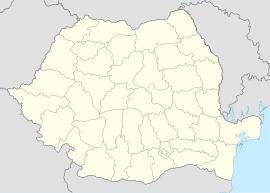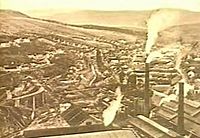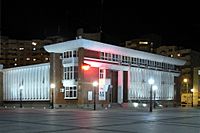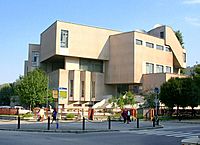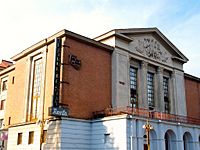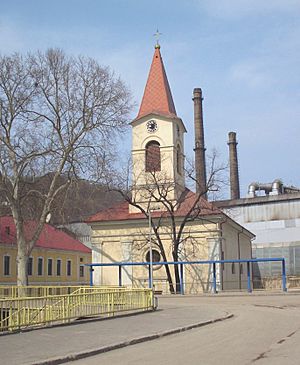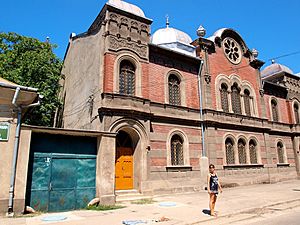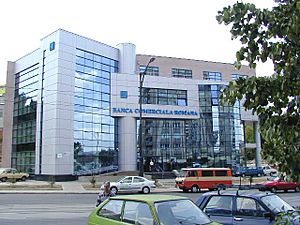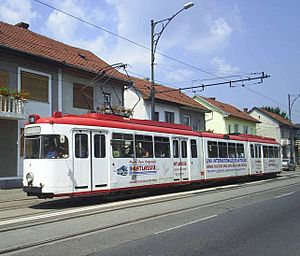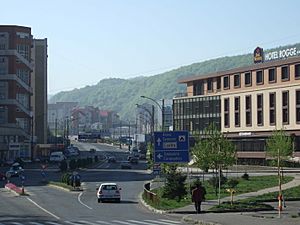Reșița facts for kids
Quick facts for kids
Reșița
|
||
|---|---|---|
|
Reșița downtown and distant view of Govândari neighborhood
Town Hall
Community center
Synagogue
Train station
|
||
|
||
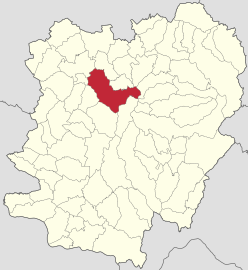
Location in Caraș-Severin County
|
||
| Country | ||
| County | Caraș-Severin | |
| Area | 197.65 km2 (76.31 sq mi) | |
| Elevation | 208 m (682 ft) | |
| Population
(2011)
|
Lua error in Module:Wd at line 1,575: attempt to index field 'wikibase' (a nil value). | |
| Time zone | EET/EEST (UTC+2/+3) | |
| Postal code |
320011–320236
|
|
| Area code | (+40) 02 55 | |
Reșița is a city in western Romania. It is the capital of Caraș-Severin County. The city is located in the Banat region. In 2021, about 58,393 people lived here. Reșița also manages six nearby villages: Câlnic, Cuptoare, Doman, Moniom, Secu, and Țerova.
Contents
What's in a Name?
The name Reșița might come from the Latin word recitia. This word means "cold spring". A historian named Nicolae Iorga thought the Romans gave this name to the city.
Another idea is that the name comes from a Slavic word. People from a nearby village called Carașova used to say "u rečice" (at the creek) when talking about this place. Many Slavic countries have places named Rečice.
A Look at Reșița's History
Reșița's history goes back to the 15th century. It was first known as Rechyoka and Rechycha. Scientists have found signs of people living here since the Neolithic (New Stone Age), Dacian, and Roman times.
The town was mentioned in 1673 as Reszinitza. Its citizens paid taxes to Timișoara. By the late 1600s, it was part of the Bocșa District.
On July 3, 1771, Reșița became a major center for making metal. Factories were built near two villages: Reșița Română and Reșița Montană. At first, Reșița Montană was home to Romanians. Later, in 1776, about 70 German families moved there. For many years, Germans were the largest group in the city.
Reșița was a rural area until 1925. Then, it became a town because it grew into a strong industrial place in Romania. In 1968, it became a municipality, which is a larger type of city.
After the Romanian Revolution in 1989, Reșița's economy faced challenges. Its population also decreased. Today, the Reșița Steelworks is run by TMK Europe GmbH. They are working to modernize the factory.
Exploring the City
Reșița is located along the Bârzava River. The Doman River joins the Bârzava in the city center. Most of the city is built along the Bârzava. Some homes are in the hills around it.
The city has three main parts:
- Romanian Reșița (also called Olah Resitza)
- Highland Reșița (also called Eisenwerk Reschitza or Nemet Reschitza)
- Bârzava's Meadow, a newer area with tall buildings.
City Areas
| Neighbourhood name |
Official name | Former name | Occasional name | Additional name | |
|---|---|---|---|---|---|
| New City | Bârzava's Meadow | New Reșița | North Reșița | Govândari | |
|
This area was built after 1965. It has four main zones called microraions:
|
|||||
| Downtown | City Centre | Romanian Reșița | South Reșița | N/A | |
|
This area was rebuilt after 1947. It includes:
|
|||||
| Old City | Commuter belt (Romanian: Muncitoresc) |
Highland Reșița | Old Reșița | N/A | |
|
This part has the oldest buildings, mostly houses. It includes:
|
|||||
The city's main center was partly updated in 2006. A cool kinetic fountain, designed by Constantin Lucaci, is a popular spot there.
Other important cultural places in Reșița include the Concrete School and the Polyvalent Hall.
The Reșița Steam Locomotive Museum is an open-air museum. It shows Romania's first locomotive, which was built in Reșița in 1872.
Reșița is a key center for making iron and steel. It has blast furnaces, iron foundries, and factories that make electrical items, chemicals, and machines.
The city is also a great place for fun activities. Nearby places include the ski resort at Semenic, Lake Gozna, Lake Secu, and the Trei Ape Lake.
People of Reșița
| Historical population | |||||||||||||||||||||||||||||||||||||||||||
|---|---|---|---|---|---|---|---|---|---|---|---|---|---|---|---|---|---|---|---|---|---|---|---|---|---|---|---|---|---|---|---|---|---|---|---|---|---|---|---|---|---|---|---|
|
|
||||||||||||||||||||||||||||||||||||||||||
In 2021, Reșița had a population of 58,393 people. In 2011, there were 65,509 people living in the city. Most people in Reșița are Romanians. There are also groups of Germans, Hungarians, Serbians, and Romany.
Places of Worship
Reșița has many churches and places of worship. Some of the main ones include:
- Roman Catholic churches:
- Saint Mary of the Snows Church (Old City)
- Trinity Sunday Church (Govândari)
- Orthodox churches:
- New Joseph from Partoș Church (City Center)
- Pentecost Church (Govândari)
- Saints Peter and Paul Church (Govândari)
- Saint Basil the Great Church (Moroasa)
- Orthodox cathedrals:
- Adormirea Maicii D-lui (Old City)
- Schimbarea la Față (Govândari)
- Lutheran church (Old City)
- Reformed church (Old City)
- Eastern Catholic church (Govândari)
- Synagogue (Old City)
Weather in Reșița
Reșița has a humid continental climate. This means it has warm summers and cold winters.
| Climate data for Reșița | |||||||||||||
|---|---|---|---|---|---|---|---|---|---|---|---|---|---|
| Month | Jan | Feb | Mar | Apr | May | Jun | Jul | Aug | Sep | Oct | Nov | Dec | Year |
| Mean daily maximum °C (°F) | 2.5 (36.5) |
4.4 (39.9) |
9.4 (48.9) |
15.1 (59.2) |
19.5 (67.1) |
22.8 (73.0) |
24.7 (76.5) |
25 (77) |
20 (68) |
15.1 (59.2) |
9.9 (49.8) |
3.8 (38.8) |
14.4 (57.8) |
| Daily mean °C (°F) | −1.1 (30.0) |
0.5 (32.9) |
4.8 (40.6) |
10.2 (50.4) |
14.8 (58.6) |
18.3 (64.9) |
20.2 (68.4) |
20.3 (68.5) |
15.5 (59.9) |
10.4 (50.7) |
5.8 (42.4) |
0.5 (32.9) |
10.0 (50.0) |
| Mean daily minimum °C (°F) | −4.4 (24.1) |
−3.3 (26.1) |
-0 (32) |
4.7 (40.5) |
9.4 (48.9) |
13 (55) |
14.9 (58.8) |
15.1 (59.2) |
11 (52) |
6.2 (43.2) |
2.4 (36.3) |
−2.4 (27.7) |
5.6 (42.0) |
| Average precipitation mm (inches) | 74 (2.9) |
69 (2.7) |
78 (3.1) |
102 (4.0) |
108 (4.3) |
121 (4.8) |
105 (4.1) |
86 (3.4) |
90 (3.5) |
72 (2.8) |
70 (2.8) |
82 (3.2) |
1,057 (41.6) |
| Source: https://en.climate-data.org/europe/romania/caras-severin/resita-844/ | |||||||||||||
Reșița's Economy
Reșița has been known as a major industrial city in Romania. It is important for making steel and vehicles. The first factories were built in 1771. These factories, known as Reșița works, have supported the city for over 300 years.
After 1989, Reșița's economy faced some difficulties. However, it has started to get better. This is thanks to new investments from inside and outside the country, especially in factories.
- Industry: The city has factories for cars, iron, textiles, and construction.
- Services: This includes restaurants, shops, and transportation.
- Tourism: There are companies that help people visit and enjoy the area.
Shopping in Reșița
Reșița has many places to shop. There are several large supermarkets like Carrefour, Lidl, and Kaufland. The main shopping center is called Nera Shopping Center. New shopping centers are also being built.
Getting Around Reșița
Public Transport
Reșița has a public transport system with buses and trams. It is run by a company called Transport Urban Reșița (TUR).
Buses
Reșița has about 25 buses that run on 6 different lines:
- 1M/2: Marginea – Minda – Mol/Mopar/Molizilor
- 4: Moroasa II – Lend/Baraj (dam of Secu Lake) – CET – Molizilor – Moroasa II
- 8: Intim – Moniom – Intim
- 9: Intim – Țerova – Intim
- 10: Nera – Doman – Nera
- 11: Piața Republicii – Minda – Cuptoare – Piața Republicii
Trams
Reșița used to have a tram system from 1988 to 2011. It is now being rebuilt and updated. The tram system will have two main lines. The goal is to reopen the trams in 2024.
Trains
Reșița also has train services.
Road Transport
The city has a main four-lane road that connects different neighborhoods. Other parts of the city can be reached by smaller roads. Roads in Reșița are generally well-kept. Traffic is usually smooth, and serious accidents are rare.
Reșița is connected to other cities like Caransebeș (which leads to Bucharest) and Timișoara by national roads. There are also county roads connecting Reșița to Oravița, Naidăș, and Anina.
Famous People from Reșița

Many talented people come from Reșița, including:
- Cristian Chivu (born 1980), a famous football (soccer) player.
- Ciprian Foias (1933–2020), a mathematician.
- Christian Gabriel (born 1975), a chess grandmaster.
- Flavius Koczi (born 1987), an artistic gymnast.
- Werner Stöckl (born 1952), a handball player.
- Francisc Vaștag (born 1969), a boxer.
Sports in Reșița
Reșița is home to several sports teams:
- Football (Soccer): CSM Reșița
- Handball: HC Adrian Petrea and CSM Reșița
Sister Cities
Reșița has "sister city" relationships with many cities around the world. This means they share cultural ties and friendly connections.
Images for kids
See also
 In Spanish: Reșița para niños
In Spanish: Reșița para niños


